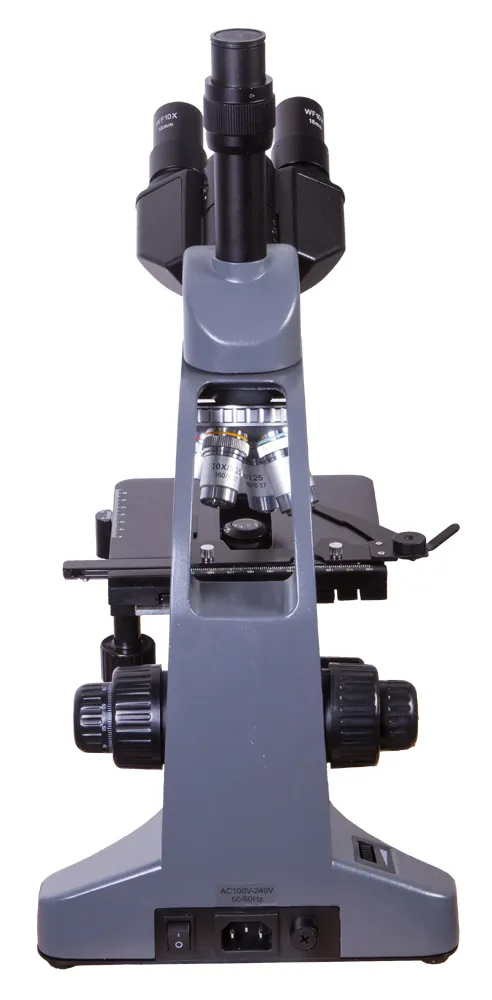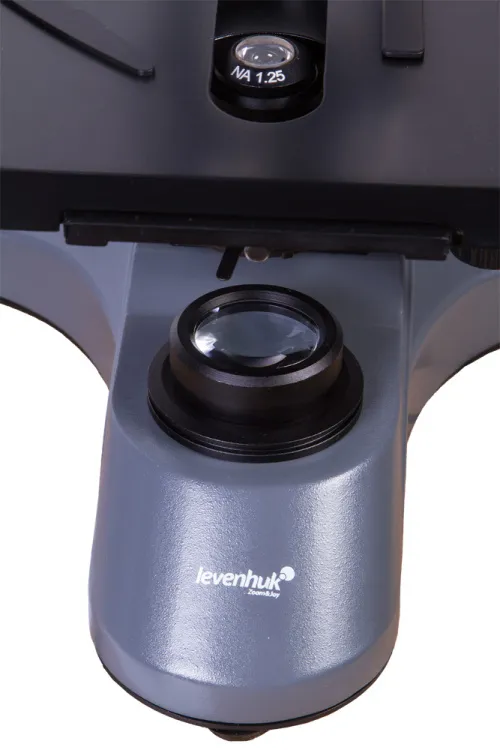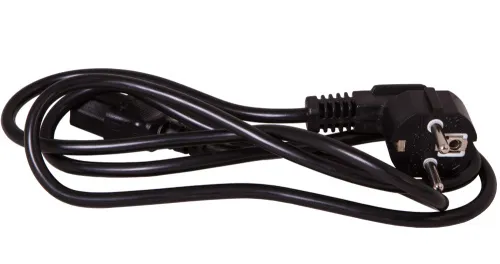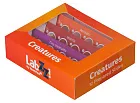Levenhuk 740T Trinocular Microscope
Magnification: 40–2000x. Comes with high-quality achromatic objective lenses and Abbe condenser with iris diaphragm
| Product ID | 69657 |
| Brand | Levenhuk, Inc., USA |
| Warranty | lifetime |
| EAN | 5905555004600 |
| Package size (LxWxH) | 49x40x27 cm |
| Shipping Weight | 5.68 kg |
Levenhuk 740T Microscope – trinocular microscope, which enables you to carry out classic biological studies and employ modern technology in your observations. Trinocular head allows you to install any digital camera adapted to the 23.2mm eyepiece tube.
The microscope is equipped with lower illumination – that means you can observe only transparent microscope samples. The intensity of light is adjustable over a wide range. An Abbe condenser repeatedly amplifies the light beam and directs it exactly on the area of research. The microscope allows for observations in the bright field mode. It also allows using the oil immersion method.
The revolving nosepiece is designed to accommodate four objective lenses. Combining them with interchangeable eyepieces of different magnification, you can obtain a wide range of fixed magnification in the 40x–2000x range. All eyepieces that come in the kit are paired.
Trinocular head is inclined at 45° and rotates 360° around its axis. This is especially convenient for group work, when you need to let a wide audience access the observed samples – just turn the microscope head, instead of moving the whole instrument.
Samples are fixed on the stage using two convenient metal clips. The stage itself moves vertically and horizontally, allowing you to accurately determine the area of research and focus on a small part of the sample. The focusing mechanism allows for fine and coarse sharpness adjustment. Most amateur microscope models lack this useful feature.
The microscope comes with a special dust cover for convenient storage of the instrument.
Features:
- Revolving nosepiece for 4 objectives
- Oil immersion
- Abbe condenser with iris diaphragm and filter
- Trinocular head
- Ability to connect a digital camera (not included)
- Magnification: from 40x to 2000x
- Metal body
- Illumination with adjustable brightness
- Convenient stage that moves vertically and horizontally
- Coaxial coarse and fine focusing mechanism
The kit includes:
- Microscope stand with base
- Trinocular head
- Achromatic objective lenses: 4x, 10x, 40xs, and 100xs (oil)
- Eyepieces: WF10x and WFH20x
- Filters (blue, yellow, green)
- Bottle of immersion oil
- Dust cover
- AC adapter
- Allen key
- Spare fuse
- User manual
- Lifetime warranty
Caution: Please refer to the specifications table for the correct mains voltage and never attempt to plug a 110V device into 220V outlet and vice versa without using a converter. Remember that mains voltage in the U.S. and Canada is 110V and 220–240V in most European countries.
Some things you can see under a microscope:





Levenhuk 740T Trinocular Microscope is compatible with Levenhuk digital cameras (purchased separately). Levenhuk cameras are installed in the eyepiece tube instead of an eyepiece.
| Product ID | 69657 |
| Brand | Levenhuk, Inc., USA |
| Warranty | lifetime |
| EAN | 5905555004600 |
| Package size (LxWxH) | 49x40x27 cm |
| Shipping Weight | 5.68 kg |
| Type | biological, light/optical |
| Microscope head type | trinocular |
| Optics material | optical glass |
| Head | 360 ° rotatable |
| Head inclination angle | 45 ° |
| Magnification, x | 40 — 2000 |
| Eyepiece tube diameter, mm | 23.2 |
| Eyepieces | WF10x/18mm, WFH20x |
| Objectives | achromatic: 4x, 10x, 40xs, 100xs (oil immersion) |
| Revolving nosepiece | for 4 objectives |
| Interpupillary distance, mm | 54 — 75 |
| Stage, mm | 140х130 |
| Stage moving range, mm | 75/24 |
| Stage features | mechanical double-layer |
| Eyepiece diopter adjustment, diopters | ±6 |
| Condenser | Abbe N.A. 1.25 |
| Diaphragm | iris |
| Focus | coaxial; coarse (22mm), fine (0.002mm) |
| Body | metal |
| Illumination | LED |
| Brightness adjustment | ✓ |
| Power supply | 220V/50Hz |
| Light source type | 3W LED |
| Light filters | blue, green, yellow |
| Additional | length of the ocular tube: 160mm specimen movement range: 75x55mm |
| User level | experienced users |
| Assembly and installation difficulty level | easy |
| Application | laboratory/medical |
| Illumination location | lower |
| Research method | bright field |
| Pouch/case/bag in set | dust cover |
We have gathered answers to the most frequently asked questions to help you sort things out
Find out why studying eyes under a microscope is entertaining; how insects’ and arachnids’ eyes differ and what the best way is to observe such an interesting specimen
Read this review to learn how to observe human hair, what different hair looks like under a microscope and what magnification is required for observations
Learn what a numerical aperture is and how to choose a suitable objective lens for your microscope here
Learn what a spider looks like under microscope, when the best time is to take photos of it, how to study it properly at magnification and more interesting facts about observing insects and arachnids
This review for beginner explorers of the micro world introduces you to the optical, illuminating and mechanical parts of a microscope and their functions
Short article about Paramecium caudatum - a microorganism that is interesting to observe through any microscope






















